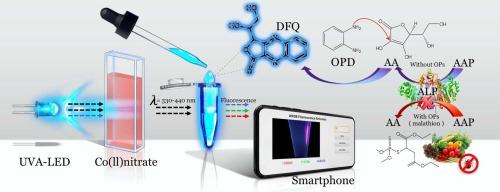A fluorescence biosensor for organophosphorus pesticide detection with a portable fluorescence device-based smartphone
IF 4.3
2区 化学
Q1 SPECTROSCOPY
Spectrochimica Acta Part A: Molecular and Biomolecular Spectroscopy
Pub Date : 2024-10-24
DOI:10.1016/j.saa.2024.125330
引用次数: 0
Abstract
An innovative fluorescence biosensor was successfully developed to detect organophosphorus pesticide (OPs) by utilizing smartphone technology. The assay relied on the enzymatic activity of alkaline phosphatase (ALP), which facilitated the conversion of L-ascorbic acid 2-phosphate sesquimagnesium salt hydrate (AAP) into L-ascorbic acid (AA). The AA that generated was then reacted with o-phenylenediamine (OPD) to yield a fluorescent marker identified as 3-(1,2-dihydroxyethyl)furo[3,4-b]quinoxalin-1(3H)-one (DFQ). A novel bandpass approach was specifically developed for a smartphone that was integrated with a customized portable fluorescence device to measure the fluorescence emission of DFQ. The device has a unique application that converts the fluorescence intensity into an RGB signal. In the presence of OPs, malathion was chosen as the representative of the OPs substance; the enzymatic activity of the ALP was inhibited, resulting in a decrease in fluorescence intensity, which was proportional to the concentration of malathion. Smartphones can be used to measure fluorescence emission, offering a calibration sensitivity more than 70 times higher than that of conventional spectrofluorometer. The recently developed methodology can be employed to identify malathion within the concentration range of 0.1–1 ppm, with a detection limit of 0.05 ppm. The practical applicability of the method was established using vegetable samples, and the acquired results were in good agreement with those obtained using the standard HPLC approach. This innovative method provides both portability and accuracy, while also exhibiting a notable degree of sensitivity in detecting trace amounts of OPs.

利用基于便携式荧光装置的智能手机检测有机磷农药的荧光生物传感器
利用智能手机技术,成功开发了一种创新的荧光生物传感器来检测有机磷农药(OPs)。该检测方法依赖于碱性磷酸酶(ALP)的酶活性,它能促进 L-抗坏血酸 2-磷酸倍半镁盐水合物(AAP)转化为 L-抗坏血酸(AA)。生成的 AA 随后与邻苯二胺(OPD)反应,产生一种荧光标记物,即 3-(1,2-二羟乙基)呋喃并[3,4-b]喹喔啉-1(3H)-酮(DFQ)。专门为智能手机开发了一种新型带通方法,该方法与定制的便携式荧光设备集成,用于测量 DFQ 的荧光发射。该设备具有独特的应用功能,可将荧光强度转换为 RGB 信号。在 OPs 存在的情况下,选择马拉硫磷作为 OPs 物质的代表;ALP 的酶活性受到抑制,导致荧光强度下降,而荧光强度与马拉硫磷的浓度成正比。智能手机可用于测量荧光发射,其校准灵敏度是传统分光荧光仪的 70 多倍。最近开发的方法可用于鉴定浓度范围为 0.1-1 ppm 的马拉硫磷,检测限为 0.05 ppm。利用蔬菜样品确定了该方法的实际适用性,所获得的结果与使用标准高效液相色谱法获得的结果非常一致。这种创新方法不仅具有便携性和准确性,而且在检测痕量 OPs 方面表现出显著的灵敏度。
本文章由计算机程序翻译,如有差异,请以英文原文为准。
求助全文
约1分钟内获得全文
求助全文
来源期刊
CiteScore
8.40
自引率
11.40%
发文量
1364
审稿时长
40 days
期刊介绍:
Spectrochimica Acta, Part A: Molecular and Biomolecular Spectroscopy (SAA) is an interdisciplinary journal which spans from basic to applied aspects of optical spectroscopy in chemistry, medicine, biology, and materials science.
The journal publishes original scientific papers that feature high-quality spectroscopic data and analysis. From the broad range of optical spectroscopies, the emphasis is on electronic, vibrational or rotational spectra of molecules, rather than on spectroscopy based on magnetic moments.
Criteria for publication in SAA are novelty, uniqueness, and outstanding quality. Routine applications of spectroscopic techniques and computational methods are not appropriate.
Topics of particular interest of Spectrochimica Acta Part A include, but are not limited to:
Spectroscopy and dynamics of bioanalytical, biomedical, environmental, and atmospheric sciences,
Novel experimental techniques or instrumentation for molecular spectroscopy,
Novel theoretical and computational methods,
Novel applications in photochemistry and photobiology,
Novel interpretational approaches as well as advances in data analysis based on electronic or vibrational spectroscopy.

 求助内容:
求助内容: 应助结果提醒方式:
应助结果提醒方式:


